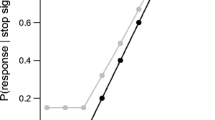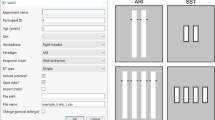Abstract
The stop-signal task (SST) is widely used for studying the speed of the latent process of response inhibition. The SST patterns are typically explained by a horse-race model (HRM) with supposed Go and Stop processes. However, HRM does not agree with the sequential-stage model of response control. As a result, the exact relationship between the response selection, the response execution stages, and the Stop process remains unclear. We propose that response selection occurs within the stop-signal delay (SSD) period, and that the competition between the Go and Stop processes occurs within the response execution period. To confirm this, we conducted two experiments. In Experiment 1, participants carried out a modified SST task with an additional stimulus category – Cued-Go. In the Cued-Go trials, cues were followed by imperative Go signals. The Cue-Go period duration was dynamically adjusted by an adaptive algorithm based on the response times reflecting the individual response selection duration. In Experiment 2, Cued-Go stimuli were followed by Stop Signals in half of the trials and response inhibition efficiency was calculated. The results of Experiment 1 indicate that SSD reflects the duration of the response selection process. The results of Experiment 2 show that this process has an independent and small effect on the effectiveness of controlled inhibition of the target response. Based on our findings, we propose a two-stage model of response inhibition in SST, with the first stage including response selection process and the second stage response inhibition following the SS presentation.




Similar content being viewed by others
Data availability
Data for the experiments reported here are available via the Open Science Framework at https://osf.io/whqgy/, and none of the experiments was preregistered.
References
Albajara Sáenz, A., Septier, M., Van Schuerbeek, P., Baijot, S., Deconinck, N., Defresne, P., Delvenne, V., Passeri, G., Raeymaekers, H., Salvesen, L., Victoor, L., Villemonteix, T., Willaye, E., Peigneux, P., & Massat, I. (2020). ADHD and ASD: Distinct brain patterns of inhibition-related activation? Translational Psychiatry, 10(1), 24. https://doi.org/10.1038/s41398-020-0707-z
Bissett, P. G., Jones, H. M., Poldrack, R. A., & Logan, G. D. (2021). Severe violations of independence in response inhibition tasks. Science Advances, 7(12), eabf4355. https://doi.org/10.1126/sciadv.abf4355
Boucher, L., Palmeri, T. J., Logan, G. D., & Schall, J. D. (2007). Inhibitory control in mind and brain: An interactive race model of countermanding saccades. Psychological Review, 114(2), 376–397. https://doi.org/10.1037/0033-295X.114.2.376
Brown, S. D., & Heathcote, A. (2008). The simplest complete model of choice response time: Linear ballistic accumulation. Cognitive Psychology, 57(3), 153–178. https://doi.org/10.1016/j.cogpsych.2007.12.002
Carrillo-de-la-Peña, M. T., Bonilla, F. M., & González-Villar, A. J. (2019). Effect of the stop-signal modality on brain electrical activity associated with suppression of ongoing actions. Biological Psychology, 143, 85–92. https://doi.org/10.1016/j.biopsycho.2019.01.010
Castro-Meneses, L. J., & Sowman, P. F. (2018). Stop signals delay synchrony more for finger tapping than vocalization: A dual modality study of rhythmic synchronization in the stop signal task. PeerJ, 6, e5242. https://doi.org/10.7717/peerj.5242
Chao, H. H., Luo, X., Chang, J. L., & Li, C. S. (2009). Activation of the pre-supplementary motor area but not inferior prefrontal cortex in association with short stop signal reaction time--an intra-subject analysis. BMC Neuroscience, 10, 75. https://doi.org/10.1186/1471-2202-10-75
Chikazoe, J., Jimura, K., Hirose, S., Yamashita, K., Miyashita, Y., & Konishi, S. (2009). Preparation to inhibit a response complements response inhibition during performance of a stop-signal task. The Journal of neuroscience : the official journal of the Society for Neuroscience, 29(50), 15870–15877. https://doi.org/10.1523/JNEUROSCI.3645-09.2009
Diederich, A., & Colonius, H. (2021). A two-stage diffusion modeling approach to the compelled-response task. Psychological Review, 128(4), 787–802. https://doi.org/10.1037/rev0000224
Faul, F., Erdfelder, E., Lang, AG. et al. G*power 3: A flexible statistical power analysis program for the social, behavioral, and biomedical sciences. Behavior Research Methods 39, 175–191 (2007). https://doi.org/10.3758/BF03193146
Ficarella, S. C., & Battelli, L. (2019). Motor preparation for action inhibition: A review of single pulse TMS studies using the go/NoGo paradigm. Frontiers in Psychology, 10. https://doi.org/10.3389/fpsyg.2019.00340
Haith, A. M., Pakpoor, J., & Krakauer, J. W. (2016). Independence of movement preparation and movement initiation. The Journal of Neuroscience, 36(10), 3007–3015.
Hommel, B. (2000). The prepared reflex: Automaticity and control in stimulus-response translation. In S. Monsell & J. Driver (Eds.), Control of cognitive processes: Attention and performance (Vol. XVIII, pp. 247–273). MIT Press.
Job, X., Golemme, M., Bhattacharya, J., Cappelletti, M., de Fockert, J., & van Velzen, J. (2019). The influence of motor preparation on the processing of action-relevant visual features. Scientific Reports, 9(1), 11084. https://doi.org/10.1038/s41598-019-47640-4
Korolczuk, I., Burle, B., & Coull, J. T. (2018). The costs and benefits of temporal predictability: Impaired inhibition of prepotent responses accompanies increased activation of task-relevant responses. Cognition, 179, 102–110. https://doi.org/10.1016/j.cognition.2018.06.006
van de Laar, M. C., van den Wildenberg, W. P., van Boxtel, G. J., & van der Molen, M. W. (2014). Development of response activation and inhibition in a selective stop-signal task. Biological Psychology, 102, 54–67. https://doi.org/10.1016/j.biopsycho.2014.06.003
Lee, W. T., & Kang, M. S. (2020). Electrophysiological evidence for distinct proactive control mechanisms in a stop-signal task: An individual differences approach. Frontiers in Psychology, 11, 1105. https://doi.org/10.3389/fpsyg.2020.01105
Li, C. S. R., Krystal, J. H., & Mathalon, D. H. (2005). Fore-period effect and stop-signal reaction time. Experimental Brain Research, 167, 305–309. https://doi.org/10.1007/s00221-005-0110-2
Logan, G. D., & Cowan, W. B. (1984). On the ability to inhibit thought and action: A theory of an act of control. Psychological Review., 91, 295–327. https://doi.org/10.1037/0033-295X.91.3.295
Logan, G. D., Cowan, W. B., & Davis, K. A. (1984). On the ability to inhibit simple and choice reaction time responses: A model and a method. Journal of Experimental Psychology. Human Perception and Performance, 10(2), 276–291. https://doi.org/10.1037//0096-1523.10.2.276
Logan, G. D., Van Zandt, T., Verbruggen, F., & Wagenmakers, E. J. (2014). On the ability to inhibit thought and action: General and special theories of an act of control. Psychological Review, 121(1), 66–95. https://doi.org/10.1037/a0035230
Maslovat, D., Chua, R., Klapp, S. T., & Franks, I. M. (2018). Preparation of timing structure involves two independent sub-processes. Psychological Research, 82(5), 981–996. https://doi.org/10.1007/s00426-017-0877-3
Maslovat, D., Klapp, S. T., Forgaard, C. J., Chua, R., & Franks, I. M. (2019). The effect of response complexity on simple reaction time occurs even with a highly predictable imperative stimulus. Neuroscience Letters, 704, 62–66. https://doi.org/10.1016/j.neulet.2019.03.056
Meyer, D. E., & Kieras, D. E. (1997). A computational theory of executive cognitive processes and multiple-task performance: Part 2. Accounts of psychological refractory-period phenomena. Psychological Review, 104(4), 749–791. https://doi.org/10.1037/0033-295X.104.4.749
Middlebrooks, P. G., & Schall, J. D. (2014). Response inhibition during perceptual decision making in humans and macaques. Attention, Perception & Psychophysics, 76(2), 353–366. https://doi.org/10.3758/s13414-013-0599-6
Morein-Zamir, S., & Kingstone, A. (2006). Fixation offset and stop signal intensity effects on saccadic countermanding: A crossmodal investigation. Experimental Brain Research, 175(3), 453–462. https://doi.org/10.1007/s00221-006-0564-x
Peirce, J., Gray, J. R., Simpson, S., MacAskill, M., Höchenberger, R., Sogo, H., & Lindeløv, J. K. (2019). PsychoPy2: Experiments in behavior made easy. Behavior Research Methods, 51(1), 195–203. https://doi.org/10.3758/s13428-018-01193-y
Ratcliff, R., & McKoon, G. (2008). The diffusion decision model: Theory and data for two-choice decision tasks. Neural Computation, 20(4), 873–922. https://doi.org/10.1162/neco.2008.12-06-420
Shin, Y. K., & Proctor, R. W. (2018). Evidence for distinct steps in response preparation from a delayed response paradigm. Acta Psychologica, 191, 42–51. https://doi.org/10.1016/j.actpsy.2018.08.010
Sigman, M., & Dehaene, S. (2005). Parsing a cognitive task: A characterization of the Mind's bottleneck. PLoS Biology, 3(2). https://doi.org/10.1371/journal.pbio.0030037
Soghoyan, G., Aksiotis, V., Rusinova, A., Myachykov, A., & Tumyalis, A. (2022). An adaptive paradigm for detecting the individual duration of the preparatory period in the choice reaction time task. PLoS One, 17(9), e0273234. https://doi.org/10.1371/journal.pone.0273234
Sternberg, S. (2001). Separate modifiability, mental modules, and the use of pure and composite measures to reveal them. Acta Psychologica, 106(1-2), 147–246. https://doi.org/10.1016/s0001-6918(00)00045-7
Sun, P., & Landy, M. S. (2016). A two-stage process model of sensory discrimination: An alternative to drift-diffusion. The Journal of neuroscience : the official journal of the Society for Neuroscience, 36(44), 11259–11274. https://doi.org/10.1523/JNEUROSCI.1367-16.2016
Thomaschke, R., Kiesel, A., & Hoffmann, J. (2011a). Response specific temporal expectancy: Evidence from a variable foreperiod paradigm. Attention, Perception, & Psychophysics, 73(7), 2309–2322. https://doi.org/10.3758/s13414-011-0179-6
Thomaschke, R., Wagener, A., Kiesel, A., & Hoffmann, J. (2011b). The specificity of temporal expectancy: Evidence from a variable foreperiod paradigm. Quarterly Journal of Experimental Psychology, 64(12), 2289–2300. https://doi.org/10.1080/17470218.2011.616212
Verbruggen, F., & Logan, G. D. (2009). Proactive adjustments of response strategies in the stop-signal paradigm. Journal of Experimental Psychology. Human Perception and Performance, 35(3), 835–854. https://doi.org/10.1037/a0012726
Verbruggen, F., Aron, A. R., Band, G. P., Beste, C., Bissett, P. G., Brockett, A. T., Brown, J. W., Chamberlain, S. R., Chambers, C. D., Colonius, H., Colzato, L. S., Corneil, B. D., Coxon, J. P., Dupuis, A., Eagle, D. M., Garavan, H., Greenhouse, I., Heathcote, A., Huster, R. J., et al. (2019). A consensus guide to capturing the ability to inhibit actions and impulsive behaviors in the stop-signal task. eLife, 8, e46323. https://doi.org/10.7554/eLife.46323
Wang, W., Hu, S., Ide, J. S., Zhornitsky, S., Zhang, S., Yu, A. J., & Li, C. R. (2018). Motor preparation disrupts proactive control in the stop signal task. Frontiers in Human Neuroscience, 12, 151. https://doi.org/10.3389/fnhum.2018.00151
Zylberberg, A., Ouellette, B., Sigman, M., & Roelfsema, P. R. (2012). Decision making during the psychological refractory period. Current Biology, 22(19), 1795–1799. https://doi.org/10.1016/j.cub.2012.07.043
Funding
The research leading to these results has received funding from the Basic Research Program at the National Research University Higher School of Economics.
Author information
Authors and Affiliations
Corresponding author
Ethics declarations
Conflicts of interests
The authors have no relevant financial or non-financial interests to disclose.
Ethics approval
Approval was obtained from the ethics committee of the Higher School of Economics. The procedures used in this study adhere to the tenets of the Declaration of Helsinki.
Consent to participate
Informed consent was obtained from participants included in the study.
Additional information
Publisher’s note
Springer Nature remains neutral with regard to jurisdictional claims in published maps and institutional affiliations.
Rights and permissions
Springer Nature or its licensor (e.g. a society or other partner) holds exclusive rights to this article under a publishing agreement with the author(s) or other rightsholder(s); author self-archiving of the accepted manuscript version of this article is solely governed by the terms of such publishing agreement and applicable law.
About this article
Cite this article
Aksiotis, V., Myachykov, A. & Tumyalis, A. Stop-signal delay reflects response selection duration in stop-signal task. Atten Percept Psychophys 85, 1976–1989 (2023). https://doi.org/10.3758/s13414-023-02752-y
Accepted:
Published:
Issue Date:
DOI: https://doi.org/10.3758/s13414-023-02752-y




